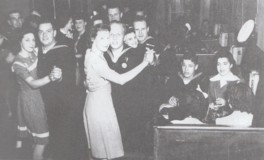Books: by Title: Geneva 1940-1970
 During World War II and the construction
of the Routes 5 and 20 bypass in the 1950s. Many factories ceased
operLike many American towns, Geneva changed dramatically in the
mid-20th century. Geneva: 1940-1970 examines
events that influenced the city, among them the influx of sailors
and workers at the nearby Sampson Naval Training Station dation
during this time, and downtown businesses began feeling pressure
from a new shopping plaza and stores on the edge of town. During World War II and the construction
of the Routes 5 and 20 bypass in the 1950s. Many factories ceased
operLike many American towns, Geneva changed dramatically in the
mid-20th century. Geneva: 1940-1970 examines
events that influenced the city, among them the influx of sailors
and workers at the nearby Sampson Naval Training Station dation
during this time, and downtown businesses began feeling pressure
from a new shopping plaza and stores on the edge of town.
The book also captures the social life of the community and
notable people who visited Geneva, such as Bobby Kennedy and Jane
Russell, and those who grew up here, such as legendary jazz
bassist Scott LaFaro.
From the introduction to Geneva 1940-1970:
Geneva felt the coming of World War II with a mixture of
fear and excitement. No one relished the thought of going to
war or having a loved one in combat. However, the
government's decision to place an ordnance depot and a naval
training station near Geneva meant economic opportunity that
had not been seen in years. There were jobs for locals and
newcomers alike. One carpenter from Binghamton, New York, who
worked on the construction of both facilities told his
brother: "You've got to come over here -- they're paying
a dollar a day!"
The Geneva Historical Society has been preserving local
history since 1883 and has collected some 15,000 photographs,
including 11,000 left by prolific photojournalist P. B. Oakley. Geneva:
1940-1970 showcases more than 200 Oakley images that
were specially selected by the historical society's curator of
collections John Marks and its former executive director Charles
Bauder.
 ----> (During the 1940's, Geneva
became a boomtown. This scene is in one of Geneva's
"nightclubs," where Geneva young people gathered for
refreshment and to dance with U.S. Navy men. By 1944, additional
bars and nightclubs sprang up to satisfy the demand for eating
and entertainment to the enlarged population. Three movie
theaters were operating around the clock, and the diners were
feeding as many as 2,400 people a day.) ----> (During the 1940's, Geneva
became a boomtown. This scene is in one of Geneva's
"nightclubs," where Geneva young people gathered for
refreshment and to dance with U.S. Navy men. By 1944, additional
bars and nightclubs sprang up to satisfy the demand for eating
and entertainment to the enlarged population. Three movie
theaters were operating around the clock, and the diners were
feeding as many as 2,400 people a day.)
ISBN: 978-0-7385-5512-6
$21.99
| 

 During World War II and the construction
of the Routes 5 and 20 bypass in the 1950s. Many factories ceased
operLike many American towns, Geneva changed dramatically in the
mid-20th century. Geneva: 1940-1970 examines
events that influenced the city, among them the influx of sailors
and workers at the nearby Sampson Naval Training Station dation
during this time, and downtown businesses began feeling pressure
from a new shopping plaza and stores on the edge of town.
During World War II and the construction
of the Routes 5 and 20 bypass in the 1950s. Many factories ceased
operLike many American towns, Geneva changed dramatically in the
mid-20th century. Geneva: 1940-1970 examines
events that influenced the city, among them the influx of sailors
and workers at the nearby Sampson Naval Training Station dation
during this time, and downtown businesses began feeling pressure
from a new shopping plaza and stores on the edge of town. ----> (During the 1940's, Geneva
became a boomtown. This scene is in one of Geneva's
"nightclubs," where Geneva young people gathered for
refreshment and to dance with U.S. Navy men. By 1944, additional
bars and nightclubs sprang up to satisfy the demand for eating
and entertainment to the enlarged population. Three movie
theaters were operating around the clock, and the diners were
feeding as many as 2,400 people a day.)
----> (During the 1940's, Geneva
became a boomtown. This scene is in one of Geneva's
"nightclubs," where Geneva young people gathered for
refreshment and to dance with U.S. Navy men. By 1944, additional
bars and nightclubs sprang up to satisfy the demand for eating
and entertainment to the enlarged population. Three movie
theaters were operating around the clock, and the diners were
feeding as many as 2,400 people a day.)
